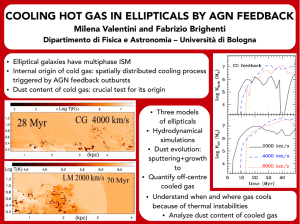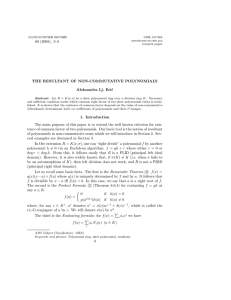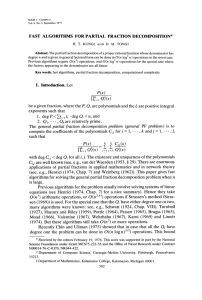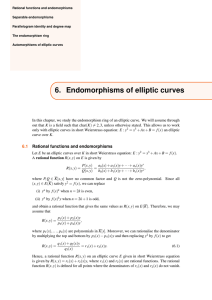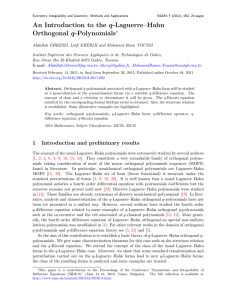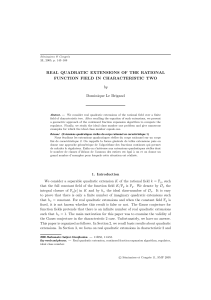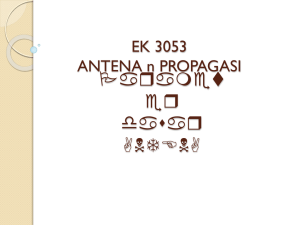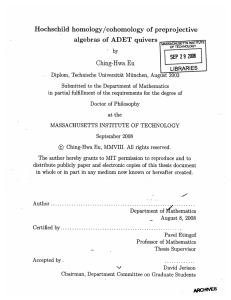Recent Advances in Astrometry with the VLBA
advertisement
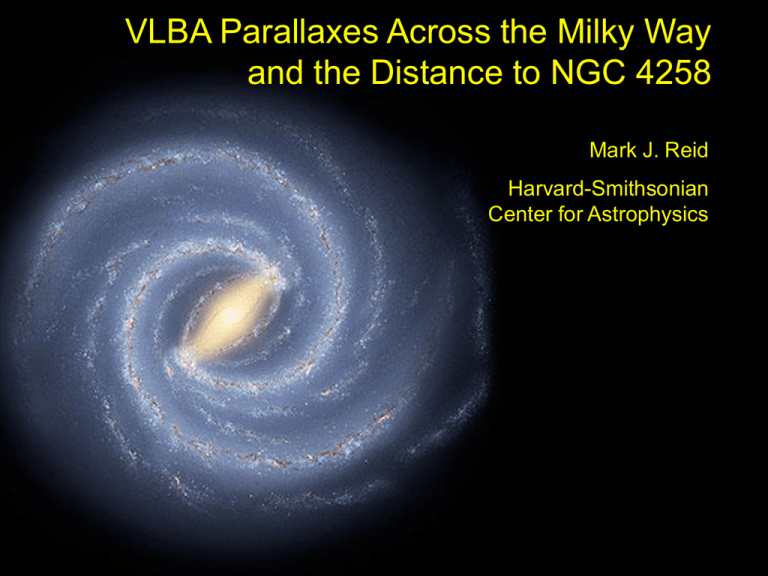
VLBA Parallaxes Across the Milky Way and the Distance to NGC 4258 Mark J. Reid Harvard-Smithsonian Center for Astrophysics Trigonometric Parallax D(parsecs) = 1 / A(arcseconds) 1 parsec = 3.26 light years = 205,000 A.U. p d(kpc) = 1 / p(mas) Nearest stars: d = 1 pc p = 1” d Center of Milky Way: d ~ 10 kpc p ~ 0.1 mas Other galaxies d ~ 1 Mpc p ~ 1 mas 1 A.U. Friedrich Wilhelm Bessel • Used Fraunhofer’s last telescope p = 0.37” ± 0.03” measured first stellar parallax: 61 Cygni: p = 0.314” in 1838 (p = 0.287”) p = 0.25” ± 0.03” Friedrich Wilhelm Bessel (1838) HIPPARCOS (HIgh Precision PARallax COllecting Satellite) 118,000 stellar parallaxes sp ~ 0.001 arcseconds 10% accuracy at 100 pc… mapped solar neighborhood (Perryman et al 1997 A&A 323 49) Pleiades Distance Problem • Hipparcos: D = 120.2 ± 1.9 pc • Ground based • HST (3 parallaxes): D = 131 135 pc D = 134.6 ± 3.1 pc • VLBA (4 parallaxes): D = 136.2 ± 1.2 pc Carl Melis et al (in prep) uncertainty dominated by cluster depth (2.3pc), not measurement accuracy Very Long Baseline Interferometry: VLBA, VERA & EVN Fringe spacing (eg, VLBA): qf~l/D ~ 1 cm / 8000 km = 250 mas Centroid Precision: 0.5 qf / SNR ~ 10 mas Systematics: path length errors ~ 2 cm (~2 l) shift position by ~ 2qf ~ 500 mas • Radio waves “see” through galaxy • Can “synthesize” telescope the size of the Earth Relative positions (to QSOs): DQ ~ 1 deg (0.02 rad) cancel systematics: DQ*2qf ~ 10 mas What does the Milky Way look like? Hipparcos range Gaia range (± 10 to 20 mas); but cannot see through dust in Galactic plane VLBI range (± 5 to 20 mas): can “see” through plane to massive star forming regions that trace spiral structure The BeSSeL Survey Team M. Reid, T. Dame (CfA) K. Menten, A. Brunthaler, B. Zhang, Y. Wu, M. Sato, Y. Choi, A. Sanna (MPIfR) X-W Zheng, Y. Xu (Nanjing) L. Moscadelli (Arcetri) A. Bartkiewicz (Torun) K. Hachisuka (Shanghai) K. Rygl (Netherlands) Parallax for W 49N H2O masers p = 90 ± 7 mas (D=11.1 ± 0.9 kpc) Zhang+ (2013) Mapping Spiral Structure • Parallaxes: VLBA, EVN & VERA >100 parallaxes for massive young stars • Tracing most spiral arms, eg… Outer arm traced Perseus arm “gap” Local arm significant • Model entire data set: R0 = 8.34 ± 0.16 kpc Q0 = 240 ± 8 km/s QR ~ 0 Reid et al 2014 Local Group Proper Motions • 1920s van Maanen claimed to see M33 spin! • mas/yr motions Spiral nebulae nearby (Galactic) • Hubble argued more distant (extra-galactic) • van Maanen’s error not found M33 Extragalactic Proper Motions • van Maanen experiment: M33 M33/19 – M33/IC133 masers VLBA: Dmx = 30 +/- 2, Dmy = 10 +/- 5 mas/yr HI: Dvx = 106 +/-20, Dvy = 35 +/- 20 km/s D = 750 +/- 50 +/- 140 kpc sm sv • Next: M31 (Andromeda) 5 masers higher rotation speed Brunthaler+ 2006 NGC 4258 • Seyfert 2 galaxy • H2O masers in edge-on warped disk Radius 0.15 -> 0.30 pc Rotation speed ~ 1000 km/s Period ~ 1000 years M ~ 4 x 107 Msun • Decade of VLBA and GBT observation • Geometric model Distance • With HST observations, recalibrate Cepheid PL relation Herrnstein, Greenhill, Moran, Miyoshi… NGC 4258: Accretion Disk (r ~ 0.1 pc) Parameter Valuea Modeling Disk Dynamics Distance, D (Mpc) 7.60 ± 0.17 A = V2 / r & r = D q Black hole mass, M bh (× 107 M ) 4.00 ± 0.09 M ~ r V2 Galaxy systemic velocity, vsys (km s− 1 ) 474.25 ± 0.49 Dynamical center x-position, X 0 b (mas) − 0.204 ± 0.005 Dynamical center y-position, Y0b (mas) 0.560 ± 0.006 Inclination, i 0 (deg) 71.74 ± 0.48 Inclination warp, di / dr (deg/ mas) 2.49 ± 0.11 Position angle, Ω0 (deg) 65.46 ± 0.98 Position angle warp, dΩ/ dr (deg/ mas) 5.23 ± 0.30 Position angle warp, d2Ω/ 2dr 2 (deg/ mas2 ) − 0.24 ± 0.02 Eccentricity, e 0.006 ± 0.001 Periapsis angle, ω0 (deg) 293.5 ± 64.4 Periapsis angle warp change, dω/ dr (deg/ mas) 59.5 ± 10.2 a √ et al (2013) Uncertainties have been scaledHumphreys by χ 2 / N , i.e., 1.403. b Positions are measured relative to that of maser emission at Center of P-V diagram VLBA map Very small Base Model 7.596 ± 0.167 2.20 Modeling Disk Dynamics S y st e m a t ic U n ce r t a in t ie s Value in Dist ance Base Model ∆ D from r Base Model or rm s est im at e (Mp c) (Mp c) (%) 1.0 km s− 1 7.624 0.028 0.37 30 µas 7.639 0.043r 0.57 0.3 km s − 1 yr − 1 7.564 -0.032 0.42 Different init ial condit ionsa — — ± 0.114 1.50 Assum ing eccent ricity is zero — 7.619 0.023 0.30 Inclusion of d2 i / dr 2 t erm (solves t o -0.112± 0.034 deg m as− 2 ) — 7.562 -0.034 0.45 Unm odeled spiral st ruct ure — — ± 0.076 1.00 Diffe ent hv-feat ure velocity uncert aint ies (0.7 & 1.3 km s − 1 ) Different y-error floor (20 µas) Diffe ent accelerat ion error floor (0.5 km s − 1 yr − 1 ) S y st e m a t ic U n ce r t a in t ie s A d d e d in Q u a d r a t u r e 0.15 2.0 % U n c e r t a in t y in t h e M a s e r D is t a n c e t o N G C 4 2 5 8 b 0.23 3.0 % Estimating H0 • DNGC4258 = 7.60 ± 0.17 ± 0.20 Mpc (total ±3%) Extremely accurate, direct distance to a galaxy. • H0 = Vrec/ D very uncertain (Vrec = Vobs – Vpec) But, very useful for re-calibrating Cepheids… H0,NGC4258 = 72.0 ± 3.0 km/s/Mpc H0,NGC4258 = 70.6 ± 3.3 km/s/Mpc (see Riess+ 2011,12) (see Efstathiou 2014) • Established H2O megamaser method for distances. Observe similar AGN disks in galaxies where Vpec << Vrec and estimate H0 directly without standard candels.

